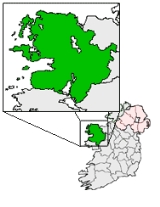
Aughagower
Encyclopedia
Aughagower or Aghagower is a tiny village
in rural County Mayo
in western Ireland
. It is located about 5 km from Westport
. Modern Aughagower has only a few houses and pubs in a pastoral setting. It also forms the centre of a parish
of the same name. The village is primarily known today for its ancient and cultural history.
Aughagower is said to have been visited by St. Patrick, on his journey to Croagh Patrick
. Aughagower lies mid-way along Tóchar Phádraig
, formerly a part of the royal processional route from Croaghan (the ancient capital of Connaught
), and later an important pilgrimage route from Ballintubber Abbey
to Croagh Patrick
.
 The ruins of a medieval church adjoins the graveyard of the town's modern religious institution. It has a well preserved tenth century round tower
The ruins of a medieval church adjoins the graveyard of the town's modern religious institution. It has a well preserved tenth century round tower
, with the exception of its topmost section and capstone. The tower was built between 973 and 1013. According to legend, the capstone was struck by lightning, and landed half a mile away on the hill of Tavenish. A local woman is said to have carried the heavy cap stone in her apron to the church where it still remains today.
Village
A village is a clustered human settlement or community, larger than a hamlet with the population ranging from a few hundred to a few thousand , Though often located in rural areas, the term urban village is also applied to certain urban neighbourhoods, such as the West Village in Manhattan, New...
in rural County Mayo
County Mayo
County Mayo is a county in Ireland. It is located in the West Region and is also part of the province of Connacht. It is named after the village of Mayo, which is now generally known as Mayo Abbey. Mayo County Council is the local authority for the county. The population of the county is 130,552...
in western Ireland
Republic of Ireland
Ireland , described as the Republic of Ireland , is a sovereign state in Europe occupying approximately five-sixths of the island of the same name. Its capital is Dublin. Ireland, which had a population of 4.58 million in 2011, is a constitutional republic governed as a parliamentary democracy,...
. It is located about 5 km from Westport
Westport, County Mayo
Westport is a town in County Mayo, Ireland. It is situated on the west coast at the south-east corner of Clew Bay, an inlet of the Atlantic Ocean....
. Modern Aughagower has only a few houses and pubs in a pastoral setting. It also forms the centre of a parish
Parish
A parish is a territorial unit historically under the pastoral care and clerical jurisdiction of one parish priest, who might be assisted in his pastoral duties by a curate or curates - also priests but not the parish priest - from a more or less central parish church with its associated organization...
of the same name. The village is primarily known today for its ancient and cultural history.
Aughagower is said to have been visited by St. Patrick, on his journey to Croagh Patrick
Croagh Patrick
Croagh Patrick , nicknamed the Reek, is a tall mountain and an important site of pilgrimage in County Mayo, Republic of Ireland. It is from Westport, above the villages of Murrisk and Lecanvey. It is the third highest mountain in County Mayo after Mweelrea and Nephin. On "Reek Sunday", the last...
. Aughagower lies mid-way along Tóchar Phádraig
Patrick's Causeway
Patrick's Causeway is an old pilgrim road to Croagh Patrick in the west of Ireland in County Mayo.The road is named after Saint Patrick, Ireland's patron saint, but pre-dates Christianity; it was probably built around 350AD, as the main route from Cruachan to Cruachan Aigle, the pagan name for...
, formerly a part of the royal processional route from Croaghan (the ancient capital of Connaught
Connacht
Connacht , formerly anglicised as Connaught, is one of the Provinces of Ireland situated in the west of Ireland. In Ancient Ireland, it was one of the fifths ruled by a "king of over-kings" . Following the Norman invasion of Ireland, the ancient kingdoms were shired into a number of counties for...
), and later an important pilgrimage route from Ballintubber Abbey
Ballintubber Abbey
Ballintubber Abbey is a royal abbey in Co. Mayo, Ireland, founded by King Cathal Crobdearg Ua Conchobair in 1216. It is said to be the only church in Ireland founded by an Irish king that is still in regular use....
to Croagh Patrick
Croagh Patrick
Croagh Patrick , nicknamed the Reek, is a tall mountain and an important site of pilgrimage in County Mayo, Republic of Ireland. It is from Westport, above the villages of Murrisk and Lecanvey. It is the third highest mountain in County Mayo after Mweelrea and Nephin. On "Reek Sunday", the last...
.
Round Tower

Irish round tower
Irish round towers , Cloigthithe – literally "bell house") are early medieval stone towers of a type found mainly in Ireland, with three in Scotland and one on the Isle of Man...
, with the exception of its topmost section and capstone. The tower was built between 973 and 1013. According to legend, the capstone was struck by lightning, and landed half a mile away on the hill of Tavenish. A local woman is said to have carried the heavy cap stone in her apron to the church where it still remains today.
See also
- List of towns and villages in Ireland

